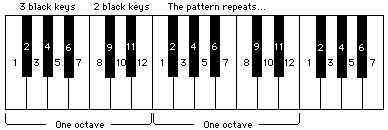
Pitch is the impression of the highness or lowness of sound and is related to the frequency of the sound or waves per second, measured in hertz. However, not all instruments produce a definite pitch. Many drums and other percussion instruments can be tuned to a pitch, but the sounds of others cannot be said to be a particular pitch at all.
Most of us do not hear melodies the way we see colors. We can always recognize green or red as a separate perception, but our impression of pitch is usually relative. That is, instead of recognizing a melody because of the sequence of particular absolute pitches (C to G to F for example), we recognize the relative pitches, that is, the interval, or distance from one pitch to the next, regardless of the starting pitch. We will hear a certain sequence of intervals as "Happy Birthday" no matter what pitch it starts on.
The interval called an octave is the most fundamental one to our hearing. An octave is defined as a ratio of 2 between any two frequencies (100 hertz is an octave lower than 200 hertz, for example). The term originated from the fact that the eighth note in a Western scale arrives at a pitch an octave above the first, but not all scales have eight notes (inclusive) per octave. Notes an octave apart seem to have a kind of equivalence, represented by the fact that we give them all the same name (C or B-flat or A, for example). These pitches are each an octave apart from each other:
We hear pitches along a continuum, but musical systems and instruments tend to have a set of discrete pitches available. The way in which musicians decide which pitches to use is called a tuning system. The standard Western tuning system has 12 equally spaced notes in each octave. Here is how the twelve are configured in a standard piano keyboard:
